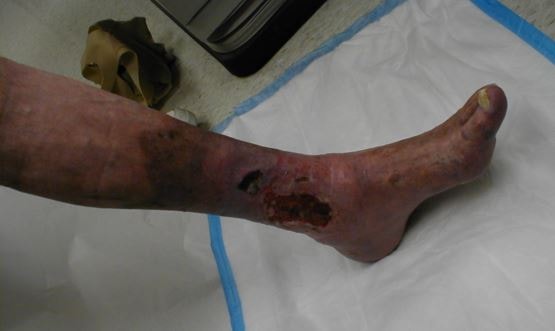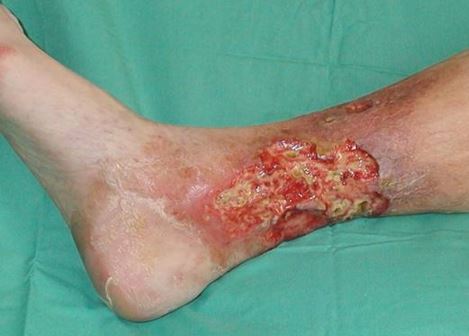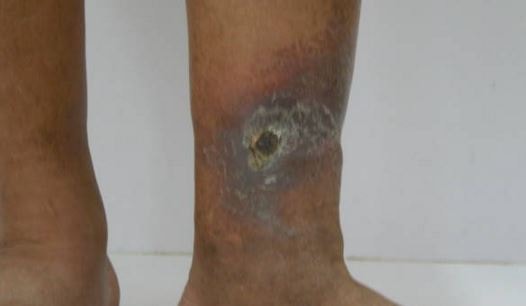Varicose Ulcer
What is Varicose Ulcer?
Varicose ulcers are also known as venous ulcers. It is a type of chronic sore on the leg or foot that can heal for a span of four weeks to six weeks. These are wounds affecting varicose veins as a result of venous valve malfunction in the lower extremities particularly the legs.

Varicose veins are the enlarged, twisted veins that are usually observed in the legs and feet of a person as a result of prolonged standing and walking. Damaged valves allows the blood to flow in the wrong direction going to the veins down the legs which is causing an elevated pressure against the veins leading to poor circulation while on a standing position. This high pressure impairs the integrity of the skin and ending up with varicose ulcers.
Causes of Varicose Ulcer
Any form of a venous disease can possibly cause a varicose ulcer due to failure of the vein to work and function properly. A varicose ulcer mainly forms in the presence of an abnormal elevated pressure against the veins of the legs.
It is considered a rare complication of varicose veins in the leg. Once the venous skin is broken due to an excessive pressure, some amount of fluid can seep out from the affected veins and tends to accumulate under the skin.
This type of fluid can thicken the skin; develop into swelling that can break down the layer of the skin, leading to an ulcer formation. The ankle area is the most common location for varicose ulcers.
There are risk factors which may lead to the formation of varicose ulcers and these are:
- Age – Varicose veins formation increase with age, so does the possibility of valve problems involving the veins.
- Sex – Women are more prone to have varicose veins due to some hormonal changes in the body during its reproductive years until the time of menopausal stage. The use of birth control injections or pills and the utilization of hormonal replacement therapy increase chances of varicose veins to worsen as its side effect.
- Obesity – An excessive weight gain or the manner of being overweight adds more pressure on a malfunctioning valve against the veins in the lower leg.
- Family history – The chance is greater when other members of the family are known to develop varicose veins too.
- Prolonged standing, walking or sitting positions – These positions impede blood circulation in the legs.
Symptoms of Varicose Ulcer
Varicose ulcers are severe painful ulcers that are formed on the skin where varicose veins are, specifically near the ankle area. A person can usually see a discolored spot on an impaired skin just before a varicose ulcer is starting to develop.
General symptoms of varicose ulcers include the following:
- Pain on the affected leg
- Feelings of itchiness in the skin sore
- Swelling of the affected leg
- Discoloration of the skin near the ulcer
- Hardening of the skin surrounding the ulcer
- Foul-smelling discharges from the skin sore
Diagnosis
Diagnosis of varicose ulcer formation is basically based on the manifestations of clinical symptoms and a thorough physical examination and the taking of medical history that is completely done by an attending physician.
Leg examinations can be done either by standing or lying down positions. A standing position enhances a more visibility of varicose veins on an affected leg.
Placing the patient on a lying down position provides an easier visibility of an existing varicose ulcer in the lower leg. Doppler study is done to rule out any problem affecting the arteries such as a peripheral artery disease. This is usually done because management for varicose ulcers is very much different when doing it for arterial problems.
Treatment
There are two main goals of treatment for varicose ulcers; first is to control an elevated pressure against the veins of an affected leg and the second is to treat an existing varicose ulcer problem.
Management of varicose ulcer can be done through:
- Regular cleaning and dressing of the wound
- An elevation of the leg from time to time to decrease the amount of pressure against the leg veins
- Application of compression bandages or compression stockings to allow an improved blood flow in the circulation
- Completion of antibiotic therapy as directed by a physician in instances of an infected varicose ulcer
- Surgery is an occasional option for those large and resistant types of ulcers which may require either a skin graft or an operative procedure to be done on an affected vein. Ulcers have to heal first when it’s due to varicose veins before a surgery can be done.
Prevention
The underlying causes in the formation of a varicose ulcer have to be properly addressed to prevent the recurrence of the same problem even after the treatment measures are done. These underlying causes are a person’s immobility, cases of obesity and the presence of varicose veins in the lower extremities.
Pictures


References:
http://www.mayoclinic.org/diseases-conditions/varicose-veins/basics/risk-factors/con-20043474
How does venous disease cause ulcers? How long will it take the ulcer to heal?, How can I stop the ulcer coming back? at http://www.circulationfoundation.org.uk/help-advice/veins/leg-ulcers/
http://www.nhs.uk/conditions/leg-ulcer-venous/pages/introduction.aspx
Spentzouris G, Labropoulos N (2009 Dec). The evaluation of lower-extremity ulcers. Semin Intervent Radiol. 26(4): 286-95.
Humphreys ML, Stewart AH, Gohel MS, et al (2007 Sep). Management of mixed arterial and venous leg ulcers. Br J Surg. 94(9): 1104-7.
Simon DA, Dix FP, McCollum CN (2004 Jun). Management of venous leg ulcers. BMJ. 5; 328(7452):1358-62.
